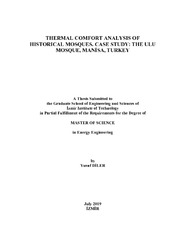Please use this identifier to cite or link to this item:
https://hdl.handle.net/11147/7493Full metadata record
| DC Field | Value | Language |
|---|---|---|
| dc.contributor.advisor | Gökçen Akkurt, Gülden | - |
| dc.contributor.advisor | Turhan, Cihan | - |
| dc.contributor.author | Diler, Yusuf | - |
| dc.date.accessioned | 2019-12-17T08:23:14Z | |
| dc.date.available | 2019-12-17T08:23:14Z | |
| dc.date.issued | 2019-07 | - |
| dc.identifier.citation | Diler, Y. (2019). Thermal comfort analysis of historical mosques, case study: The Ulu Mosque, Manisa, Turkey. Unpublished master's thesis, İzmir Institute of Technology, İzmir, Turkey | en_US |
| dc.identifier.uri | https://hdl.handle.net/11147/7493 | - |
| dc.description | Thesis (Master)--Izmir Institute of Technology, Energy Engineering, Izmir, 2019 | en_US |
| dc.description | Includes bibliographical references (leaves: 68-70) | en_US |
| dc.description | Text in English; Abstract: Turkish and English | en_US |
| dc.description.abstract | Mosques are sanctuary places for Muslims where they can communicate with each other and perform their religious activities. Mosques differ from other building types in terms of occupancy period during a day with their unique function and intermittent operating schedule. Historical mosques with cultural heritage value, contain lots of artworks and represent Turkish culture for centuries. These mosques are originally built and serve without heating, cooling and mechanical ventilation systems. In this thesis, a systematic approach on monitoring and evaluating the microclimate and thermal comfort of historical mosques has been developed. This approach consists of two phases: detailed data collection and developing a dynamic building energy model. As a case study, The Ulu Mosque was monitored between 2015 and 2018. Thermal comfort evaluation of the mosque during worship periods were conducted based on the method provided by EN ISO 7730 standard. A dynamic Building Energy Performance Software, is used to model the mosque, and the model was calibrated by hourly indoor temperature data. The calibrated model, which meets ASHRAE 14 requirements, is used to develop retrofitting proposals. Thirteen different scenarios were proposed to improve thermal comfort during worship periods. The results were then evaluated according to EN 16883 standard in terms of the conservation of cultural heritage. Electric radiator heating with intermittent operating schedules was obtained as the best options to protect cultural heritage, while decreasing dissatisfaction level from 45% to 10% in winter months. Additionally, comparing with continuous operating schedule, intermittent operation saves 46.9% energy. | en_US |
| dc.description.abstract | Camiler, Müslümanların ibadetlerini yerine getirdikleri ve birbiriyle iletişim kurabildikleri sosyal merkezlerdir. Camiler, Ay ve Güneş’in hareketlerini referans alan değişken ibadet vakitleri ve doluluk oranlarıyla diğer yapı tiplerinden farklıdırlar. Tarihi camiler aynı zamanda kültürel değere de sahiptirler. Bir müze gibi birçok sanat eserini muhafaza edebilirler ve Türk kültürünü temsil ederler. Çoğunlukla ısıtma veya soğutma sistemleri yoktur, sadece doğal havalandırma ile serinletilirler. Bu tez çalışmasında, tarihi yapının iç ve dış ortam ikliminin izlenmesi ve değerlendirilmesi için sistematik bir yaklaşım sunulmuştur. Bu yaklaşım iki aşamadan oluşur. İlk aşama ayrıntılı veri toplama, ikincisi ise toplanan verilere dayalı bir sanal bina performans modeli oluşturmaktır. Alan çalışması olarak, Ulu Cami'de 2015-2018 yılları arasında farklı dönemlerde ölçme ve izleme gerçekleştirilmiştir. Caminin ibadet vakitlerinde ısıl konfor değerlendirmesi, EN ISO 7730 standardının sağladığı yöntemle yapılmıştır. Sanal modelin oluşturulmasında dinamik bina ısıl performans yazılımı kullanılmıştır. Daha sonra model ölçülen iç ortam sıcaklık verilerine göre ASHRAE 14 standardının gereksinimlerini karşılayacak şekilde kalibre edilmiş ve toplanan veriler, mevcut yapısal problemler ve Cami'nin tasarım özellikleri dikkate alınarak değerlendirilmiştir. Namaz vakitlerinde caminin mevcut ısıl konfor düzeyinin yetersiz olduğu belirlenmiş, ısıl konfor memnuniyet düzeyinin artırılması için on üç farklı senaryo önerilmiştir. Bu senaryolar modele uygulanmış ve EN 16883 standardına göre kültürel mirasın korunması açısından değerlendirilmiştir. Sonuç olarak, kesikli çalışma programında elektrikli radyatör ile ısıtma uygulaması hem ısıl konfor hem de kültürel mirasın korunması açılarından en iyi seçenek olarak değerlendirilmiştir. Bu senaryo ile kış aylarında kişisel memnuniyetsizlik seviyesi %45'ten %10'a düşürülürken, sürekli çalışma programlarına göre %46.9 oranında enerji tasarruf sağlanmaktadır. | en_US |
| dc.format.extent | xii, 70 leaves | - |
| dc.language.iso | en | en_US |
| dc.publisher | Izmir Institute of Technology | en_US |
| dc.rights | info:eu-repo/semantics/openAccess | en_US |
| dc.subject | Thermal comfort | en_US |
| dc.subject | Ulu Mosque in Manisa | en_US |
| dc.subject | Historical mosques | en_US |
| dc.title | Thermal Comfort Analysis of Historical Mosques, Case Study: the Ulu Mosque, Manisa, Turkey | en_US |
| dc.title.alternative | Tarihi Camilerde Isıl Konfor Analizi, Alan Çalışması: Ulu Cami, Manisa, Türkiye | en_US |
| dc.type | Master Thesis | en_US |
| dc.institutionauthor | Diler, Yusuf | - |
| dc.department | Thesis (Master)--İzmir Institute of Technology, Energy Systems Engineering | en_US |
| dc.relation.publicationcategory | Tez | en_US |
| dc.identifier.wosquality | N/A | - |
| dc.identifier.scopusquality | N/A | - |
| item.openairecristype | http://purl.org/coar/resource_type/c_18cf | - |
| item.languageiso639-1 | en | - |
| item.openairetype | Master Thesis | - |
| item.grantfulltext | open | - |
| item.fulltext | With Fulltext | - |
| item.cerifentitytype | Publications | - |
| Appears in Collections: | Master Degree / Yüksek Lisans Tezleri | |
Files in This Item:
| File | Description | Size | Format | |
|---|---|---|---|---|
| T002052.pdf | MasterThesis | 9.32 MB | Adobe PDF |  View/Open |
CORE Recommender
Page view(s)
298
checked on Mar 31, 2025
Download(s)
7,984
checked on Mar 31, 2025
Google ScholarTM
Check
Items in GCRIS Repository are protected by copyright, with all rights reserved, unless otherwise indicated.